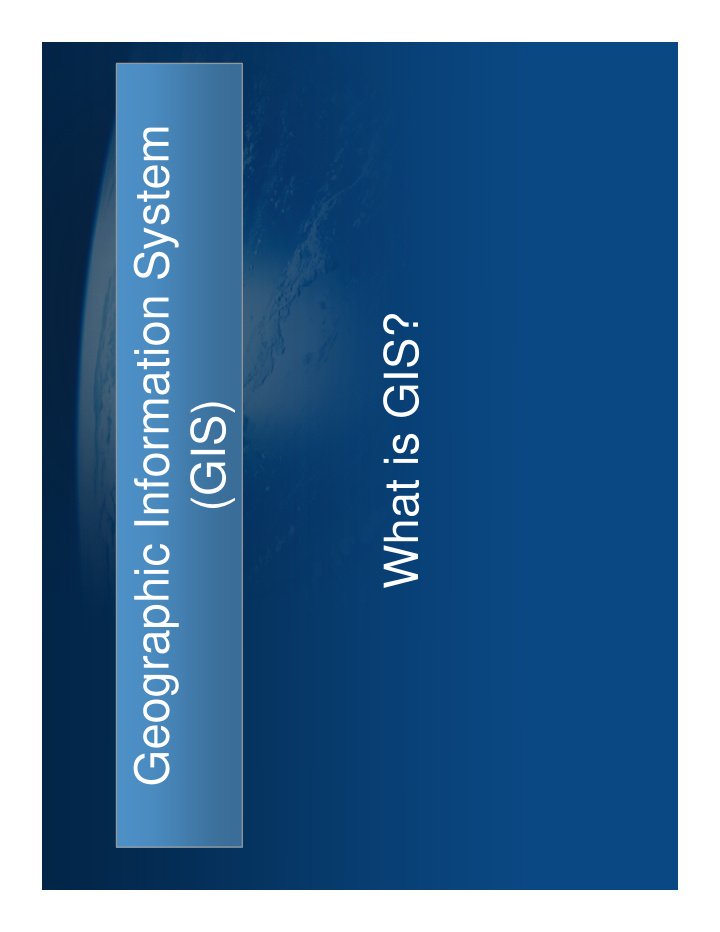



Geographic Information System What is GIS? (GIS)
Think About Geography What is Geography? • Association of American Geographers’ definition: • Geography is the science of place and space • Merriam-Webster’s definition: • A science that deals with the description, distribution, and interaction of the diverse physical, biological, and cultural features of the earth’s surface
Think About Geography Questions Geographers Ask • Where is it located? • Why is it located there? • How and why are places different? • How do people interact with their environment? The answer to these questions is spatial data
History of Cartography • The First Maps • Rock walls • Clay tablets • Uses of Maps • Topographic • Celestial • Cosmographic Picture of a cuneiform tablet from http://www.crystalinks.com/cuneiformtablets.html
Early Maps of the World Picture of a T-O map from University of Texas, Foundations of Western European Cartography
Exploring the World Mercator map picture from Encyclopedia Britannica.
Maps at War Topographic map picture of Harper’s Ferry from www.DavidRumsey.com.
Linked information reveals patterns…
What is Spatial Data? Location Data • How Many? – What Kind? – Where? Scale of Data • Local to Global to Beyond Data Presentation • Words, Charts, Graphs, Tables, or Maps Estimates are that 80% of all data has a spatial component • Data from most sciences can be analyzed spatially
Geographic Information Systems A Definition of GIS A Geographic Information System (GIS) links locational and attribute information and enables a person to visualize patterns, relationships, and trends. This process gives an entirely new perspective to data analysis that cannot be easily seen in a table or list format or on a paper map. Exploring data using GIS turns data into information and knowledge
Five Components of GIS Hardware The computer, peripherals, and sometimes servers on which the GIS operates Software Provides the functions and tools required to store, analyze, and display data Data Data is stored as vector, raster, or attribute data Methods The guidelines, specifications, standards, and procedures for collecting and analyzing data and applying GIS People GIS needs people to ask the questions; choose, collect, and analyze the data; and interpret the results
A Complete GIS Visualization • GIS as a tool to display spatial data as a map Database Management • GIS as a tool to store and organize spatial data Spatial Analysis • GIS as a tool to analyze and interpret spatial data
GIS Combines Spatial Data From Many Sources
Sources of Spatial Data Digitized and Scanned Maps • Purchased, donated, free (Internet) • Created by user Databases • Tables of data GPS • Global Positioning System • Accurate locations Field Sampling of Attributes Remote Sensing and Aerial Photography GIS stores and organizes spatial data in databases
Database Not easy to interpret
Visualization Worth a Thousand Words
Two Ways to Visualize Data “The World” in GIS Raster -- Grid • “Pixels” • A location and value • Satellite images and aerial photos are already in this format Vector -- Linear • Points, lines, and polygons Real world • “Features” (house, lake, etc.) • Attributes • size, type, length, etc .
Five Data Layers “Alike Features” Capitals Layer Lakes Layer Rivers Layer Roads Layer States Layer
Turning Data Into Information “Spatial Analysis” -- Not Just a Map
Asking a Question -- Interaction
Maps and Databases are Interactive
The Goal of GIS The goal of GIS is to help people and companies do their work better , faster , and cheaper through Visualization • GIS provides users with quicker, more accurate representations of spatial data Database Management • GIS makes it easier to keep the spatial data accurate and up to date Spatial Analysis • GIS helps users make more informed decisions *Wherever Spatial Data Analysis Is Needed*
Some Ways GIS is Used Emergency Services • Fire and Police Environmental • Monitoring and Modeling Business • Site Location, Delivery Systems Industry • Transportation, Communication, Mining, Pipelines, Healthcare Government • Local, State, Federal, Military Education • Research, Teaching Tool, Administration
Defense Management
Real Estate Management
Education
Utility Management
Transportation Management Transportation Management
Public Safety
Government
Hospital Facilities
ArcGIS ArcGIS provides users with a complete GIS • Visualization • Database Management • Spatial Analysis ArcGIS offers more than just GIS software …. offers GIS solutions. The goal is to make users more successful
ArcGIS Family of Products
ArcGIS Server Platform Desktop Explorer Mobile Open Enterprise Web Map APIs Environment Viewer Author/Serve/Use Use • Maps • Data • Models • Globes • Metadata Serve ArcGIS Server Author Making GIS Knowledge Available To Anyone . . . . . . Integrates With Other Systems Via Standards
NCDOT IT GIS UNIT NCDOT GIS Standards and Practices As part of the North Carolina Department of Transportation's efforts to maximize the value of our investment in Geographic Information Systems (GIS), data management, and access to data, we have developed geospatial standards and practices. The purpose of these standards and practices is to provide users with necessary information about the data, to support improved linking of different data sets, and to better manage the Department's GIS investments.
NCDOT IT GIS UNIT Visit our website at http://www.ncdot.org/it/gis/ Email us at www.gishelp@ncdot.gov
Recommend
More recommend